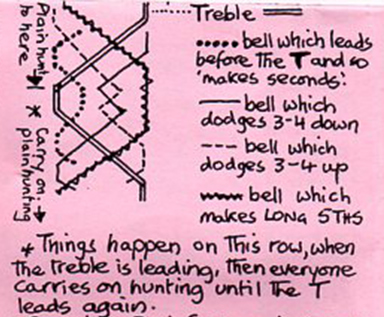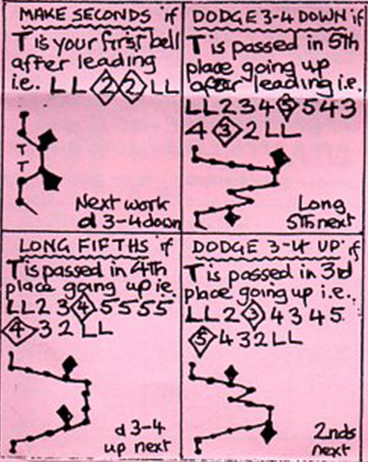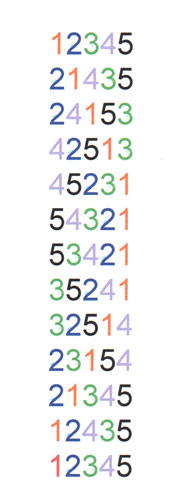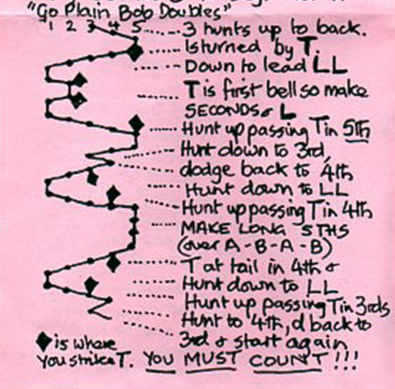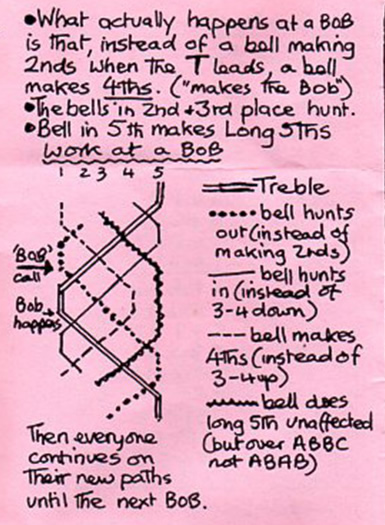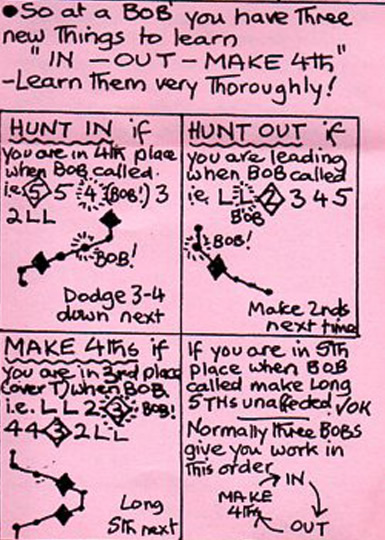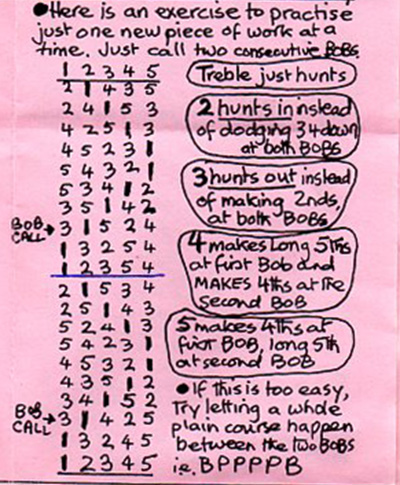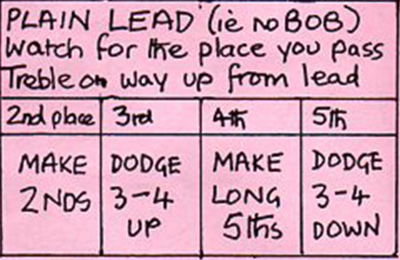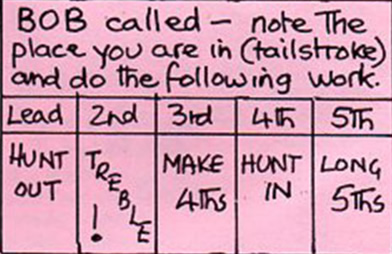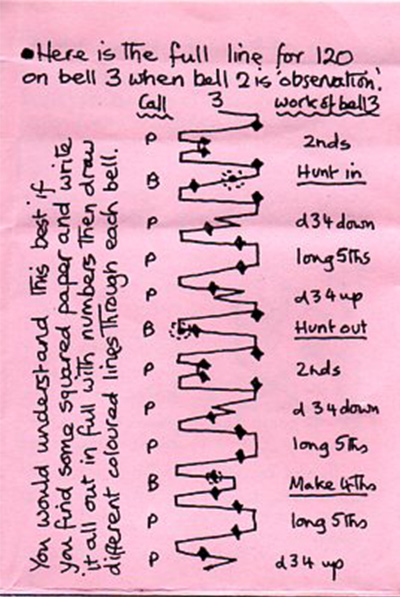Plain Bob Doubles in Easy Stages
A Mini - Leaflet
By Pam Copson, Sherbourne Teaching Aids
- Tackle these six stages in order.
- BEFORE STARTING YOU MUST BE ABLE TO HUNT THE TREBLE BY ROPESIGHT AND COUNTING YOUR PLACES!
- You will need three people who can ring Plain Bob, plus a Treble (and a Tenor on 6.)
THESE ARE YOUR SIX STAGES:
1. Understand the Plain Course
2. Practise four pieces of work
3. Ring a Plain Course
4.'Observation Bell' - Long 5ths
5. BOBS - In - Out - Make it.
6. Put it all together
1. Understanding The Plain Course
- Plain Hunting on Five bells lasts for only 10 changes (20 seconds!) before it repeats, so we need a METHOD to make it go on longer.
- One Method is 'Plain Bob Doubles'
- All we do is Plain Hunt until the Treble comes back into Lead at Handstroke.
- Then at Backstroke (Tailstroke) we do something different to change the order, then we carry on Plain Hunting.
- If this is done four times the bells get back into Rounds after 40 changes. (1 minute 20 seconds)
- What actually happens is that the bell which was in Lead just before the Treble (bell 3 the first time) lies twice over the Treble (ie MAKES SECONDS) and then leads again.
- Everyone else is blocked by this bell pushing back into Lead, for one whole pull (tail and sally). Then everyone carries on hunting.
- This whole pull is occupied by doing one step backwards (ie. a DODGE) if possibe.
- The bells in 3 and 4 place dodge.
- The bell in 5th place place has no bell to dodge with so just stays in 5th place for an extra two pulls - 'Long Fifths'.
2. Four Pieces of Work to Learn and Practise Individually.
In the plain course there are four pieces of work. You must learn them all very thoroughly.
Here is an exercise to practice just one piece of work at a time. It's called "Nervous Breakdown Bob Doubles"!
- Treble hunts but does four blows in 5th's place, and returns to lead in a different order. (Needs a good ringer)
- 2 hunts only to 4th's place. He's turned from lead by the Treble and makes 2nd's place.
- 3 passes the Treble in 3rd's place and dodges 3 - 4 up.
- 4 passes the Treble in 5th's place and dodges 3 - 4 down.
- 5 passes the Treble in 4th's place, makes Long 5th's over two bells dodging and strikes the Treble in 4th's place on the way back down to lead.
3. Ring the Plain Course.
Now you know the four bits of work so you can ring a plain course.
All the working bells (2,3,4,and 5) do the same work in the same order but each starts at a different point. Try bell number 3 to start with. Here is the line for you:
4. Observation Bell.
Bobs can be called to extend the ringing longer than the plain course.
A bell which has a regular, simple path is called the "Observation Bell", because the conductor can use it to see where to call the bobs.
In Plain Bob DOubles any bell (234 or 5) can be "Observation"
YOU can ring this Observation Bell, no problem, (so long as the conductor calls it correctly for you!)
In effect you will just ring three plain courses with the following differences:
- Each time you begin to ring Long 5th's a Bob is called (it happens three times).
- You still make Long 5th's, but over ABBC (not ABAB), and then you carry on as normal.
- This changes the other three bells around into a new order, so you will dodge with a different bell and you may find a different bell takes you from lead.
5. Understanding Bobs.
The plain course is only 40 changes, but there are 120 possible different rows (called "the extent" ).
So another special change (called a BOB) is used when the Treble leads, to produce more of the rows.
A Bob is called when the Treble is in 2nd's place (backstroke) just before leading and it takes effect at the next backstroke (sometimes called tailstroke), so you have just two seconds to react to this instruction!
A bob actually affects three bells - it switches them around so that A goes onto B's path. B goes to C's path and C goes to A's path.
So three bobs, correctly placed, will cycle these three bells round and back onto their original paths and so back to rounds. 3x 40 (plain course) = 120 (extent.)
The other bell is not affected and just rings three plain courses (Observation bell).
BOBS - four pieces of work to learn and practise individually.
6.Putting it all Together
Now you know all the bits of the 'jigsaw' which is Plain Bob Doubles.
You can do it on any bell but you may have to learn the starts.
All you need to do is to memorise the following two charts - they cover every eventuality for plain leads ( no call) and for bobs.
Here is the full line for 120 Bob Doubles on the 3, when the Observation bell is the 2.
Further Information
When starting to learn to ring methods, many learners often get 'bogged down' trying to absorb too much information. This mini leaflet gives youjust the bare essentials and is best if you tackle each stage in order.
Each stage builds on the ones before.
Your Tower Captain should arrange the ringing to suit each stage for you.
If you cannot understand any part, ask someone for help!
Study each section at home first and COUNT, COUNT, COUNT your places saying where you pass the Treble.
This must become automatic! (Other ringers may look as if they're half asleep, but they are counting silently.)

